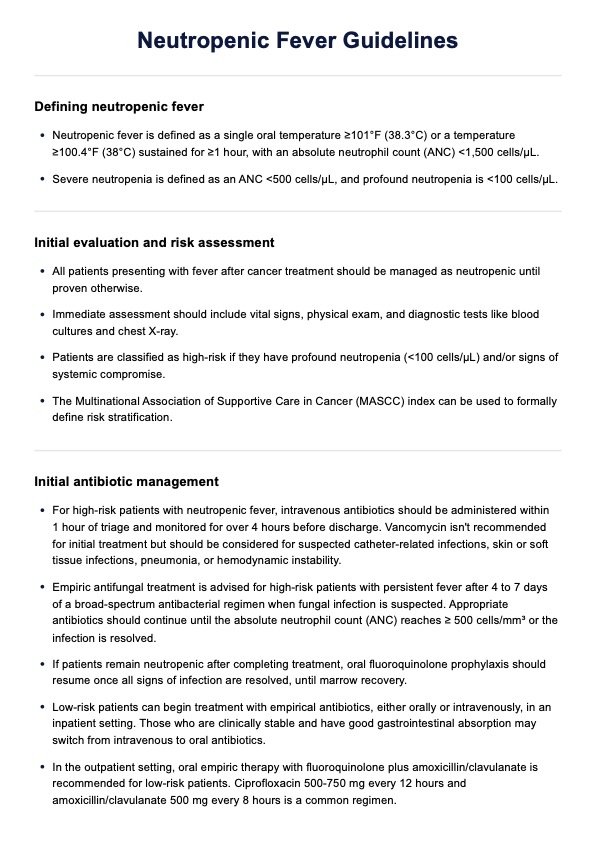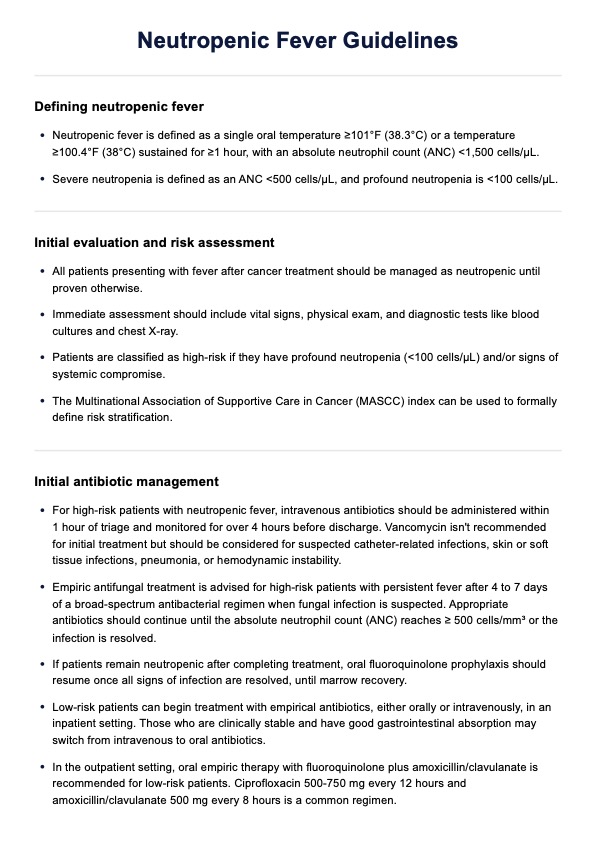Neutropenic Fever Guidelines
Discover comprehensive Neutropenic Fever Guidelines covering causes, symptoms, diagnosis, and effective treatment for patients.


What is a neutropenic fever?
Neutropenic fever is a serious medical condition that occurs when a person with neutropenia, a low level of neutrophils in the blood, develops a fever. This condition is particularly dangerous because neutrophils are crucial for fighting off infections. Without enough neutrophils, the body is less able to combat infectious agents, making even minor infections potentially life-threatening.
Causes
Neutropenic fever is typically caused by an infection, which can be bacterial, viral, or fungal. Individuals undergoing chemotherapy or radiation therapy for cancer are particularly at risk, as these treatments can damage bone marrow, reducing neutrophil production. Other causes include bone marrow disorders, certain medications, and immune system diseases.
Symptoms
The symptoms of neutropenic fever are often subtle but can escalate quickly, necessitating immediate medical attention. Common symptoms include:
- Fever (usually above 100.4°F or 38°C)
- Chills or sweating
- Shortness of breath
- Sore throat
- Mouth sores
- Abdominal pain
- Diarrhea or changes in bowel habits
Diagnosis
Diagnosing neutropenic fever involves several steps to identify the cause and determine the best course of treatment:
- Medical history and physical examination: Assessing the patient's symptoms, recent treatments, and overall health.
- Complete blood count (CBC): To measure neutrophil levels.
- Blood cultures: To identify potential bacterial infections.
- Other cultures: Such as urine, stool, or sputum cultures to identify possible sources of infection.
- Imaging tests: Such as chest X-rays or CT scans to detect any signs of infection or complications.
Neutropenic Fever Guidelines Template
Neutropenic Fever Guidelines Example
Neutropenic Fever Guidelines
Neutropenic fever is a critical condition commonly encountered in patients with cancer, particularly those undergoing cancer treatment. Effective management of this condition is crucial to prevent severe complications. This includes patients suffering from conditions like acute leukemia and acute myeloid leukemia, who are often at heightened risk due to chemotherapy-induced neutropenia.
Initial evaluation and risk assessment
Upon presentation of a fever in a patient after cancer treatment, it is crucial to manage them as neutropenic until proven otherwise. The initial evaluation of neutropenic patients includes checking vital signs, conducting a physical examination, and performing diagnostic tests such as blood cultures and a chest X-ray. Patients with profound neutropenia (ANC <100 cells/μL) or signs of systemic compromise are classified as high-risk.
Initial antibiotic management
Patients identified as high-risk patients should immediately receive initial empiric therapy. Common choices include piperacillin-tazobactam or cefepime as monotherapy. For low-risk patients, outpatient management of fever can be a safe and effective approach under strict monitoring guidelines.
For those allergic to penicillin, alternatives like aztreonam or ciprofloxacin plus vancomycin are recommended. Antibiotic therapy must be reassessed daily and adjusted based on culture results and the patient's clinical progression.
If initial antibiotic treatments do not resolve the fever, consider the possibility of invasive fungal infections, particularly in patients who remain neutropenic for extended periods, as these can complicate the clinical scenario significantly.
Supportive care
Patients with neutropenia should adhere to dietary restrictions to minimize the risk of foodborne infections. Consultations with specialists in infectious diseases may be necessary to address complex cases of neutropenic fever. Complete blood counts should also be monitored daily to track neutrophil recovery.
How to use our Neutropenic Fever Guidelines handout template
Our Neutropenic Fever Guidelines handout template is designed to assist healthcare professionals in navigating the complex care requirements of patients presenting with neutropenic fever. This easy-to-follow template outlines the essential steps for effectively using the handout.
Step 1: Download the handout
To obtain a copy of the Neutropenic Fever Guidelines handout, simply scroll down this article until you see the "Download" button. Ensure your device has suitable software, such as a PDF reader, to view and download the document.
Step 2: Familiarize yourself with the content
Thoroughly reviewing the handout to understand the various sections that outline the definition, risk assessment, management strategies, and supportive care for neutropenic fever. Familiarity with the content will ensure that you can quickly refer to relevant information when needed.
Step 3: Implement the guidelines in clinical practice
Use the handout as a clinical reference when evaluating and managing patients suspected of having neutropenic fever. The step-by-step guidelines will assist in making informed decisions about initial assessments, antibiotic therapy, and when to escalate care.
Step 4: Update regularly
Regularly check for updates to the handout. Based on new research and clinical findings, neutropenic fever management and clinical practice guidelines can change. Keeping up-to-date with the latest version of the handout ensures that patient care is based on the most current evidence and best practices.
Benefits of using this handout
This handout provides essential information and guidance on managing neutropenic fever, a common and potentially serious complication in cancer patients, with compromised immune systems. Here are several benefits of using this handout:
- Enhanced knowledge: It educates healthcare providers about the latest protocols for timely recognition and treatment of neutropenic fever.
- Standardized care: The handout promotes consistency in the medical management of neutropenic fever, which can improve patient outcomes.
- Quick reference: It serves as a quick and accessible reference for medical staff during critical situations, ensuring that the necessary steps are taken without delay.
- Improved patient safety: By following the guidelines, healthcare providers can reduce the risk of complications associated with neutropenic fever, enhancing overall patient safety.
- Resource efficiency: The handout helps streamline the decision-making process, potentially reducing the time and resources spent on managing cases of neutropenic fever.
Commonly asked questions
Neutropenic fever typically lasts as long as the underlying neutropenia persists and until the infection is effectively treated, which can vary from a few days to several weeks.
To prevent neutropenic fever, maintain good hygiene, avoid crowds and sick people, and follow your healthcare provider's guidelines regarding medications and monitoring.
While a fever is a key indicator, some people with neutropenia might not exhibit a high fever but can still have an infection, so other symptoms like chills, fatigue, and malaise should be closely monitored.







































































































